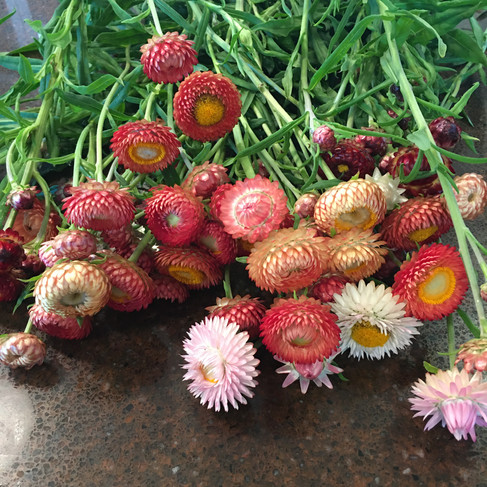Cutting Down on Cut Flowers (Assessing Crops)
- Julia Watson

- Jan 26, 2024
- 3 min read
Updated: Apr 28, 2025

In our first year of growing flowers to sell, I wanted to grow everything. It felt like I finally had permission to go bonkers and order all the seeds I’d ever dreamed of. Maybe that’s an exaggeration, but not by much. I bought a lot of seeds and our first parking strip garden* was a patchwork of many flower types that changed completely twice in the year.
But by now, going into our fifth year of Tiny Footprint Flowers, I’ve learned that not everything is worth growing. Of course, I already knew that, because I’d been growing a backyard garden for thirty years and some things I planted turned out to be disappointing. But this was a new lesson because the things I grew for Tiny Footprint had been recommended as cut flowers; they were supposed to be useful in floral arrangements! Nevertheless, I learned that not every flower is right for our flower business.
Some flowers are too aggressive, others too wimpy. Some grow well and are useful, but I simply don’t like them. In fact, the title of this post was going to be “No More Strawflowers” because that’s a flower I don’t like much and wanted to kick out of our lineup. But I changed my mind (and the blog title) because strawflowers are just too useful. I can limit them, but I won’t eliminate them. **
Strawflowers are undoubtedly useful, but that doesn't mean I like harvesting them!
Each year I learn something during the growing season, then in late summer I think about those lessons as I map out what to grow the next year, and where to plant everything. In our first year the main lessons were: too many different flowers, and some flowers need more space.
That first year we had planted our parking strip beds with 9” spacing, following advice from other flower farmers. But by mid-summer, I noticed that the most productive zinnias were in another growing bed where the plants had more space. Plants that were naturally compact - strawflowers and Fama scabiosa - were well adapted for the close spacing in our parking strip bed, but zinnias were better at wider spacing. So, in our second year I left empty space around zinnias, while keeping compact flowers 9” apart.
In our second year I learned that some flowers sound appealing in the seed catalogue but weren’t worth growing or were too aggressive. Put Silene ‘Blushing Lanterns’ in the latter category, along with Ammi (aka False Queen Anne’s Lace). They look good in a bouquet, but they can re-seed and take over! I crossed them off my list as I ordered seeds for the next year. China asters go into the first category – nice but not good enough to justify the growing space.
This process of assessing crops continues every growing year. In planning for 2024, I’ve cut back again and I have the smallest number of flowers yet, but it’s still a long list. Don is better at this than I am. He can ruthlessly cut varieties off his list, but I dither and can’t decide, then end up putting back half the things I took off my list. Or I decide to ‘trial’ a couple of new things, which can be a good practice. Hopefully we balance each other out and we’ll eventually come to the right mix of reliable flowers for our little business. If you’re a flower farmer, or an active gardener, let us know how you decide which plants to grow!
* We started Tiny Footprint Flowers by creating a flower bed in our front parking strip, a space that had only dying grass. But we already had a large back yard garden and later we added two additional growing spaces at other sites. By now, in our fifth year of Tiny Footprint Flowers, Don makes his list of flowers to grow and I choose the rest.
**Are you wondering what I have against strawflowers? They’re a pain to harvest; sticky residue stays on your hands and gloves. The leaves are not attractive, but they’re hard to strip off. The blooms can droop and bend if they’re not picked at the right stage. Yes, strawflowers dry well, but I don’t do dried flowers at all, so that’s is not a plus in my book. Having said all that, I have to admit that strawflowers are useful in late summer and fall arrangements. Many times they provided just the right touch, so I keep a few plants in the lineup. And complain each time I have to harvest them.











Comments